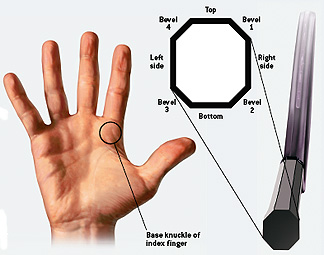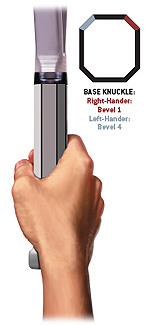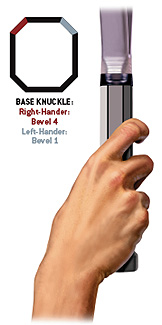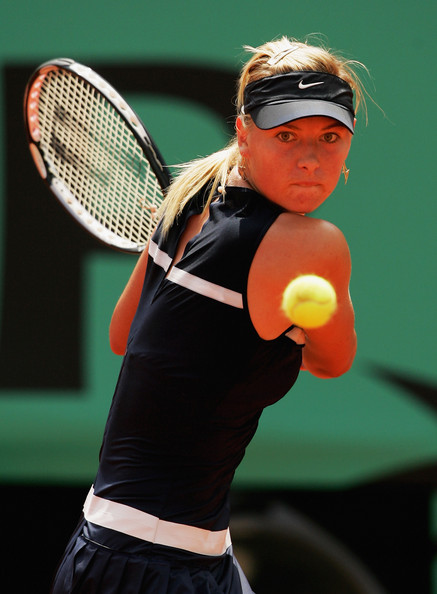If a good, comfortable grip that can add power to your shots can be discovered, you will have even more confidence in your backhand, perhaps even to the point that it becomes a weapon.
There are tons of terms thrown around when discussing the various tennis backhand grips, but they can be easily understood once you figure out which is which. No matter what any expert says about which grip is preferable, you need to decide which one feels best for you. All players’ swing planes are different and their arm motions depend on their body type, etc., thus one grip for all will never work.
Understanding the Proper Tennis Backhand Grips


Here’s an explanation of the five different tennis backhand grips. Most of the descriptions will focus on the position of the base knuckle of the index finger, as well as the thumb, because it comes into play much more than on the forehand stroke.
You can try a few or all of them and decide which one feels most comfortable and can lead to repeated solid strokes.
Just before we describe your five choices, let’s define a couple of terms that will arise again and again.
As you look at your racquet handle when it is standing on its edge, the side plane is the part of your grip that is parallel to the racquet face. The top plane is perpendicular to the racquet face and parallel to the ground. The upper right slant (also called a bevel) is the plane between the top plane and the right side plane of the racquet handle. If you think of a clock, the top plane is 12 o’clock, the upper right slant is 2 o’clock and the right side plane is 3 o’clock. 

Continental Tennis Backhand Grip


Place your base knuckle on the upper right slant and wrap your thumb straight around the handle to get the Continental grip. This grip is not a good one for hitting topspin, but it does a fine job with slice shots and flat shots. It is also an excellent grip for low shots and therefore has been favored by many grass court specialists, especially the serve-and-volley players who hit fewer ground strokes and don’t want to change grips for all of their shots.
Eastern Tennis Backhand Grip


Place your base knuckle on the right edge of the top plane (1 o’clock) and extend your thumb diagonally across the left side plane. This grip has many fans because it is quite versatile and can handle topspin, slice and flat shots with equal ease. Two adopters of this grip were Don Budge, whom some people have said had the best backhand stroke ever, and Ken Rosewall, who sliced his way to many tournament titles in the 1960s and ‘70s.
Full Eastern Tennis Backhand Grip—
Place your base knuckle on the center of the top plane and extend your thumb in a line that is more straight than diagonal across the left side plane. This grip is not drastically different than the Eastern grip, but it lends itself more to hitting topspin than the standard Eastern grip. It can also handle flat and slice shots.
Western Tennis Backhand Grip


Place the base knuckle on the left ridge of the top plane (11 o’clock) and your thumb as you would for the Full Eastern grip. This grip is preferred by those who want to hit very heavy topspin just about all of the time. That’s because it is not well suited for hitting slice or flat shots. This grip has grown in popularity in recent years, with both Roger Federer (at times) and Justine Henin using it; the results speak for themselves. Who doesn’t want to hit a backhand like those two do? Richard Gasquet, owner of another beautiful backhand stroke, also uses the Western grip.
Tennis Backhand Grips for the Two Handed Backhand Stroke
Two-handed (several combinations for left and right hand grips)—The most common tennis backhand grip is an Eastern forehand position for the left hand. However, as more players go to the Western grip, the left hand also adopts a Semi-Western forehand grip. The right hand, which grips the racquet closer to the handle, is most often using a Continental grip, but you can choose an Eastern forehand or backhand grip as well.
Thus, the most common combo is Eastern for the left hand and Continental for the right. The debate between one- and two-handed backhands will rage on. The fact is an entire generation of players has grown up with the double-handed backhand, and it is probably too late for many of them to change.
Using the Two Handed Backhand Can Be Used for Many Different Situations
The two-handed grip began way back in the 1930s, but the success of several players in the 1970s when tennis boomed, including Bjorn Borg, Chris Evert and Jimmy Connors, made the two-hander common procedure. The other historical reason given for the preponderance of two-handed backhands is the earlier learning of tennis by many players.
When a child is too weak to hit a one-handed backhand, s/he naturally grips the racquet with both hands for extra power. The two-handed backhand offers far greater racquet stability and more potential for topspin, but is definitely disadvantageous for reaching low balls and generating slice. In fact, many two-handers go to one hand when reaching for low balls, trying emergency stretch shots and slices. For these strokes, the one-handed Continental or Eastern Backhand grips are best.
The Importance of Proper Tennis Stroke Production Regardless of Tennis Backhand Grips


Obviously, no matter what tennis backhand grip you choose to adopt, if you do not practice the other fundamentals of the stroke, it won’t matter. The backhand often gets neglected during practice time because it is usually the weaker of a player’s two sides. Some players also think that they can run around their backhand at any time in a match. This is simply not true.
For that reason, the backhand should be drilled as much or more than the forehand side. If you are under-confident in your backhand, the only way that you will improve it is to practice until you gain confidence. In other words, under-confidence often leads to less practice, which leads to even lower confidence when it comes time to play a match.
Basic Tennis Backhand Technique and Tips to Keep in Mind
As you work on that backhand and get settled with your favorite tennis backhand grip, be sure to:
- Turn your body so that you are looking over your shoulder to hit the ball. Your arm should have little to do to get your racquet in excellent preparation position. Your body’s coiling should turn your arm naturally behind you to prep for a powerful backhand stroke.
- As you take your backswing, remember that it is more compact than on the forehand side. Your body should do almost all of the work to perform your backhand backswing.
- After hitting the ball with your head perfectly still, make excellent extension toward where you want the ball to go. This part of the backhand is usually the most neglected, especially because the two-handed backhand has somewhat of an awkward follow-through. It doesn’t have to look or feel awkward, however.


Take a look at a video of a top pro hitting a backhand, one- or two-handed. You will see the racquet wrap around his/her neck, almost reaching the point in the circle of the swing plane to where it began. Thinking of a bird’s eye view that is parallel to the baseline as you execute a backhand stroke, think of the shot beginning at 4 o’clock and the follow-through continuing until at least noon.
Finding the right tennis backhand grip is important to feel maximum comfort for a stroke that often feels uncomfortable. Experiment the next time you play with a few different grips and note how often you hit slices and flat shots, how often you want max topspin, etc. This will also determine which tennis backhand grip that you choose. When you have settled on the best way to hold the racquet, practice until your backhand feels natural and smooth.
Learn to Hit a Forehand Like Roger Federer
If you want to jumpstart your forehand and play like the PROS, check out my 70+ page Tennis Ebook that will immediately show you how you can take your forehand to the next level.
The Modern Forehand Domination Ebook is guaranteed to improve your tennis technique, and increase power, topspin and accuracy of your tennis forehand!
Modern Tennis Forehand Ebook
Learn How to Hit a Forehand Like Federer, Nadal and Djokovic

